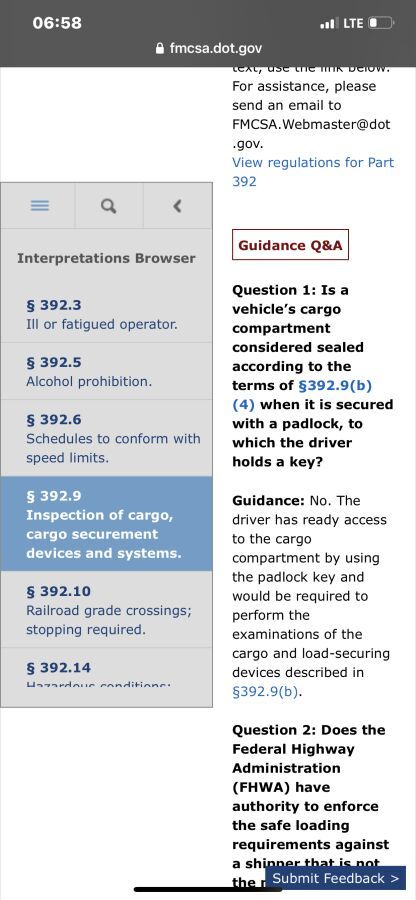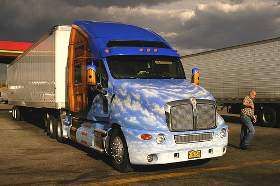3 Hrs Or 150 Mile Rule
Topic 31136 | Page 1
Are you doing flatbed ? If not, that regulation doesn’t apply. It’s there for open deck drivers so that they’ll get out, check the load securement and tarps if need be. Many will also include a quick walk around while at it since you’re on both sides of the truck anyway.
Are you doing flatbed ? If not, that regulation doesn’t apply. It’s there for open deck drivers so that they’ll get out, check the load securement and tarps if need be. Many will also include a quick walk around while at it since you’re on both sides of the truck anyway.
That rule only applies to flatbed? I did not know that. I also saw in the manuel it says that and did orientation recently and they didn't mention it was only for flatbed.
I'm currently on the road training and my trainer has me running 5hrs straight with no break. I was going to mention that to him because I'm not use to driving that much and it's my first week. Also didn't want to be a pain in the butt so I just stuck with it.
Primarily for flatbed or open deck work. It can apply to van loads though if you’re only using a padlock on the doors and you hold the key. If the load is sealed then you wouldn’t be required to do the load check. It’s a bit of a strange regulation 392.9 but usually only ever applied to open deck haulers.

I was taught 7 yrs ago that particular rule was for flatbed types. Have NEVER had a DOT inspection look at my logs and ask about why I wasn't annotating those inspections....not even when I got pulled in for two Level I and three Level III inspections in 3 weeks while working for one company that DOT later shut down. Those inspections were THOROUGH because the company was having us run illegal.
Laura
DOT:
Department Of Transportation
A department of the federal executive branch responsible for the national highways and for railroad and airline safety. It also manages Amtrak, the national railroad system, and the Coast Guard.
State and Federal DOT Officers are responsible for commercial vehicle enforcement. "The truck police" you could call them.
HOS:
Hours Of Service
HOS refers to the logbook hours of service regulations.
392.9.b.4 The rules of paragraph(b) do not apply to the driver of a sealed commercial motor vehicle who has been ordered not to open it to inspect it's cargo or to the driver of a commercial motor vehicle that has been loaded in a manner that makes inspection of it's cargo impracticable.
Commercial Motor Vehicle:
A commercial motor vehicle is any vehicle used in commerce to transport passengers or property with either:
- A gross vehicle weight rating of 26,001 pounds or more
- A gross combination weight rating of 26,001 pounds or more which includes a towed unit with a gross vehicle weight rating of more than 10,000 pounds
392.9.b.4 The rules of paragraph(b) do not apply to the driver of a sealed commercial motor vehicle who has been ordered not to open it to inspect it's cargo or to the driver of a commercial motor vehicle that has been loaded in a manner that makes inspection of it's cargo impracticable.
Exactly. However, if you read the response to that question, there’s a twist. If the “seal” is just a padlock being used by the driver, one to which the driver has the key, then they can be held responsible for load securement and checks. The likelihood of an officer every upholding it is probably slim to done, but it does exist and because of that, drivers do need to be aware of it.
Commercial Motor Vehicle:
A commercial motor vehicle is any vehicle used in commerce to transport passengers or property with either:
- A gross vehicle weight rating of 26,001 pounds or more
- A gross combination weight rating of 26,001 pounds or more which includes a towed unit with a gross vehicle weight rating of more than 10,000 pounds
Yes indeed this area is for ooen deck drivers. Like has been said it could apply to others if not sealed. For any box and tanker drivers I highly recommend you pickup some extra seals and keep them in the truck. IF a customer doesn’t seal a load you should. Keeps you complaint with this rule we are talking about, that alot of drivers don’t know, but also a very quick reference if someone has messed around with your trailer.,
Another thing people forget is if your hauling hazmat whenever you stop you are required to log a safety check. No time or distance requirement on it, just when you stop.
HAZMAT:
Hazardous Materials
Explosive, flammable, poisonous or otherwise potentially dangerous cargo. Large amounts of especially hazardous cargo are required to be placarded under HAZMAT regulations
With that being said….while not a legal requirement to stop for checks in 3 hrs or 150 miles , whenever you do stop it is ALWAYS a good idea to check for irregularities, loose lugs,or leaks and flats. Especially on the inner tires
OOS:
When a violation by either a driver or company is confirmed, an out-of-service order removes either the driver or the vehicle from the roadway until the violation is corrected.
New Reply:
New! Check out our help videos for a better understanding of our forum features

















Preview:








 TT On Facebook
TT On Facebook
I was taught at Roehl, and I also believe I read about it in CDL manual, that a driver must do safety checks every 3 hours or 150 miles whatever happens first. My trainer was not religious on that, but was aware of it, and we actually made these stops every 150-200 miles. I banged tires, checked lights, and used a bathroom. Now I see quite a few people write about driving 4+ hours straight, which makes it a violation, I guess. Is it something that is enforced or not? Do DOT officers look at these stops during inspection?
CDL:
Commercial Driver's License (CDL)
A CDL is required to drive any of the following vehicles:
DOT:
Department Of Transportation
A department of the federal executive branch responsible for the national highways and for railroad and airline safety. It also manages Amtrak, the national railroad system, and the Coast Guard.
State and Federal DOT Officers are responsible for commercial vehicle enforcement. "The truck police" you could call them.